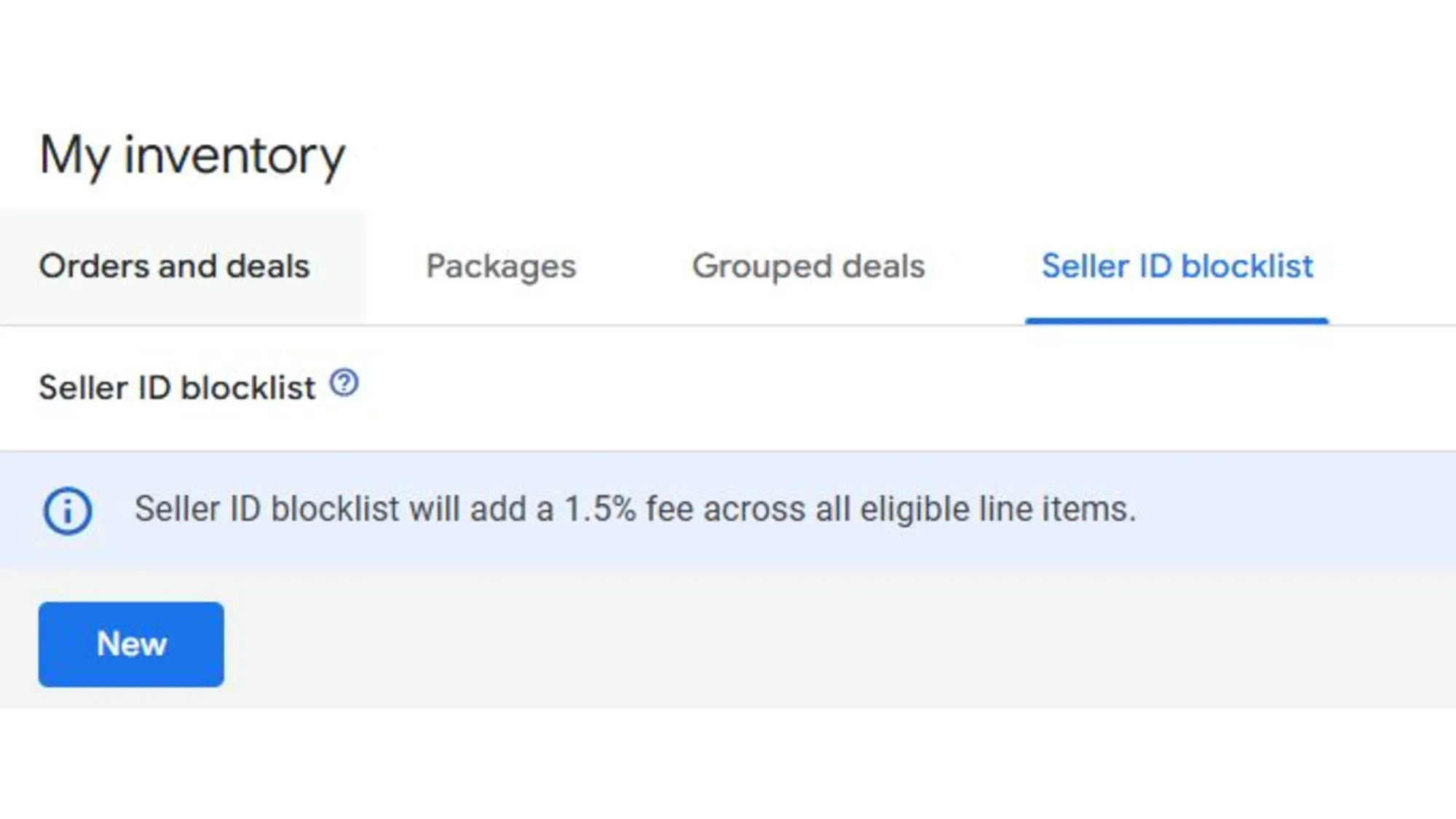DV360 introduces seller ID blocklist with additional fee
Display & Video 360 enables more granular supply path control for advertisers, but at a price.

Google's Display & Video 360 (DV360) has made its Seller ID blocklist feature available to all users. This feature, which was previously in beta, allows advertisers to curate their supply on a more granular level than just domain or app by using the Seller ID variable that remains in the bid stream.
The ability to filter by Seller ID has been fundamental to industry transparency initiatives like ads.txt and seller.json setup. However, in what industry professionals are calling a typical "Google world" approach, using this feature incurs an additional fee of 1.5% on media costs.
Seller ID blocklists enable advertisers to specify which exchange IDs and seller IDs their advertisers are blocked from targeting. Exchanges create Seller IDs to identify the different sellers on their platform and publish them in their sellers.json files.
Each partner account in DV360 can have one seller ID blocklist, which is applied to all spend from that partner. The platform checks the blocklist for each impression served, with exceptions including YouTube buys and reservation line items.
The feature represents a significant step forward in supply path optimization (SPO), giving advertisers more precise control over their programmatic supply chains.
Understanding the supply chain object
The feature leverages the SupplyChain object framework developed by the Interactive Advertising Bureau (IAB). As part of a broader effort to eliminate profit from invalid traffic, ad fraud, and counterfeit inventory in the open digital advertising ecosystem, the SupplyChain object enables buyers to see all parties who are selling or reselling a given bid request.
While ads.txt has been extremely successful in allowing publishers and app makers to define who is authorized to sell impressions, it doesn't reveal or authorize all parties involved in transacting those impressions. This information can be important to buyers for reasons including transparency of the supply chain, ensuring all intermediaries are entities they want to transact with, and that inventory is purchased as directly as possible.
The SupplyChain object consists primarily of a set of nodes where each node represents a specific entity participating in the transaction of inventory. The entire chain of nodes from beginning to end represents all entities involved in the direct flow of payment for inventory.
How to implement a Seller ID blocklist
To create a Seller ID blocklist in DV360, advertisers need to:
- Navigate to the My Inventory menu and select the Seller ID Blocklist tab
- Click "New" and enter a name for the blocklist
- Upload a CSV file that includes an exchange ID and seller ID column
- Review terms and cost increase details, then click "Agree to cost"
The CSV file should consist of records in the format <EXCHANGE ID>,<SELLER ID> separated by line breaks. The Exchange ID is the canonical domain name of the SSP, Exchange, or Header Wrapper system that bidders connect to, while the Seller ID is the identifier associated with the seller/reseller account within the advertising system.
Advertisers can obtain these values through supply chain information in ADH, by asking exchange partners, or from sellers.json files on a per-exchange basis.
Industry reception and comparison
The feature introduction has caught the attention of programmatic advertising professionals. Jonathan D'Souza-Rauto, Biddable Product Lead at Kepler, noted that this capability has been a longstanding request since the original rebrand of DoubleClick Bid Manager (DBM).
While Google introduces this feature with an additional fee, competitor DSPs have struggled to offer similar functionality. The notable exception is Microsoft Invest (formerly Xandr), where the original AppNexus team implemented this feature early in their platform development.
Brian O'Kelley, co-founder and former CEO of AppNexus (now part of Microsoft Advertising), commented on the pricing model, stating: "I really screwed up when I tried to make AppNexus transparent and low cost. So many things we could have monetized!"
In a subsequent comment, Gareth Glaser observed that modern DSPs tend to monetize numerous platform features, noting: "I've seen invoices from modern DSPs — it's like every button has a fee associated with it. Totally nuts."
Why this matters to marketers
The introduction of Seller ID blocklists in DV360 has several significant implications for digital marketers:
- Enhanced supply path control: Marketers can now filter their programmatic buys at a more granular level, potentially improving quality and reducing fraud.
- Cost considerations: The 1.5% additional fee represents a new cost factor that marketing teams must evaluate against the benefits of enhanced control.
- Competitive positioning: This feature represents another differentiator in the increasingly complex DSP landscape, where platforms compete on features, transparency, and cost structures.
- Supply chain transparency: As programmatic advertising matures, tools like this highlight the industry's movement toward greater accountability throughout the supply chain.
- Ad fraud mitigation: More precise control over supply paths can help marketers avoid questionable inventory sources that may be associated with invalid traffic.
As digital advertising environments become increasingly complex, features like Seller ID blocklists give advertisers more tools to navigate the ecosystem, albeit with associated costs that must be factored into overall campaign economics.
Industry developments timeline
- 2017: IAB Tech Lab introduces ads.txt to combat domain spoofing and unauthorized inventory sales
- 2019: IAB Tech Lab releases sellers.json and SupplyChain Object specifications
- Early 2024: DV360 begins beta testing Seller ID blocklist feature with select advertisers
- April 2025: DV360 makes Seller ID blocklist feature available to all users with 1.5% fee added to media costs
- Present: Industry continues evaluating the value proposition of enhanced supply path controls versus associated costs

